Description
djalpat wanambi
Cottonwood (Bombas Ceiba) with Ochre Pigment and PVA Fixative
147 x 15 cm
Year: 2019
ID: 3243-19
Dhulaku ga Gumiṉḏa
Wuyal was the first man to look for any homeland for the Marrakulu people. He began a journey from Gurka’wuy travelling via Yuduyudu to Cape Shield, up to Trial Bay and along the course of the Goyder River until he came to Mt. Saunders. Travelling along with Wuyal, was Ganyt’jalala. These men are symbolic of the Märi-Gutharra (grandparent-grandchild) relationship which describes the relationship between Ḏäṯiwuy and Marrakulu clans. Significant to this relationship is the fact that Ḏäṯiwuy men give their daughters daughters away to Marrakulu men for marriage. Thus the two clans share an important relationship which involves reciprocal obligations.
Wuyal carried with him tools for hunting animals and for collecting wild honey or sugarbag. The dilly bag, Bandak, worn around his neck, was used to carry the sugarbag called Guku. Wuyal used a stone axe, djalpaṯ, to cut down trees in his search for sugarbag (please note that this is the artist’s name). He also carried a stone headed spear for hunting rock wallabies, Dhulaku (kangaroo adult male Arnhem Land Euro, Macropus robustus woodwardi). This is the creature depicted in this sculpture. The stone head of the spear, guyarra, is made from stone found at a place called Nilipitji. Nilipitji is the origin point of this songline and it is a quarry inland from Numbulwar. The shaft of the spear is called gundit. Also carried was galpu, a spearthrower.
In their ancestral travels these men travelled alone without wives and conducted what was mens’ business in ceremony. Wuyal’s ceremonial ground where he danced and conducted sacred ceremony, a place near Buffalo Creek and Mt. Saunders, is called Wandjipuy.
The tools were also used in shaping the land. Trees cut down by Wuyal in the search for sugarbag, turned into rivers. The Gurka’wuy river was made in this way. Wuyal also named places by throwing his boomerang, gunyalili, and giving names to the places where it fell to the ground. From Mt. Saunders he threw his gunyalili and named a place called Galuru in this way.
On the chest of Dhulaku is a band of design the horizontal lines which divide the painting into sections, contain a dotted design which indicates Stringybark blossom sitting atop fresh spring water running over the rocks in the hilly country. The arc refers to the Galiwali or boomerang. This is the freshwater area of Yanawal described above.
Trial Bay is located between Caledon Bay to the North and above the larger Blue Mud Bay on the western side of the Gulf of Carpentaria. Deep inside Trial Bay the Marrakulu clan claim ownership to land and sea though the actions and events of Ancestor Beings as they travelled into this country imbuing their power into both land and sea. The mark of ownership is sung, danced and painted in Marrakulu ritual through the stringybark woodlands and stony country, through the freshwaters running into the Gurka’wuy River into Trial Bay. Mixing with the saltwaters through sacred mangroves and froth and bubble and out deeper into the Bay with the outgoing tide, past boulders and rocky islets the power and knowledge associated with Marrakulu Rom (law) washes back to shore. This country is associated with the Wawalak Sisters, sacred goannas, Wuyal the Sugarbag Man and the original inhabitants of Gurka’wuy since these times, the Djuwany people. The Djuwany were the first people of this country who practised the ritual according to the Creators on the beaches, who hunted the stony country and waters of both the River and Trial Bay.
Bees are the creators of the honey from the Stringybark flowers. The continuum between the environment, the art and the sacred foundation of the Marrakulu is completed when the Marrakulu dance as bees in their ceremony elbows extended ,hands clutching stringybark leaves which vibrate as wings. The hollow log of Gadayka cut down by the Ancestral Sugarbag Man, Wuyal washed down the Gurka’wuy River and into Trial Bay. The waters of the (Wuyal-created) Gurka’wuy River took the sacred log with Djerrka the freshwater goanna (another manifestation of the Djuwany Sisters identified with the freshwater mussel Djarrwit in its mouth) on board out to sea, the incoming tide then beaching the sacred lizards at Gurka’wuy. This ebb and flow is mirrored in the Yolngu cosmology that sees the spirit of Yolngu transformed from the living to the ephemeral and transported to the sacred clan reservoir of souls that it might transform again in living form. The opening stanzas of manikay (sacred song) for some Marrakulu ceremony tell of the Djerrka and the Log washing back to shore at Gurka’wuy (Djerrkawuy) on the incoming tide. The original occupants of Gurka’wuy, the Djuwany people, having arrived. The miny’tji (sacred clan design) on the chest of Gumiṉḏa depicts the mix of both the freshwaters of the Gurka’wuy river and the saltwaters of Trial Bay. The same life force as bubbles created by the activity of Djerrka in the tidal waters of Gurka’wuy. Just as Dhulaku embodies the freshwater song cycles Gumiṉḏa – the Bush Thick-knee Curlew bird characterises the coastal area of Trial Bay. This carving depicts each of them.

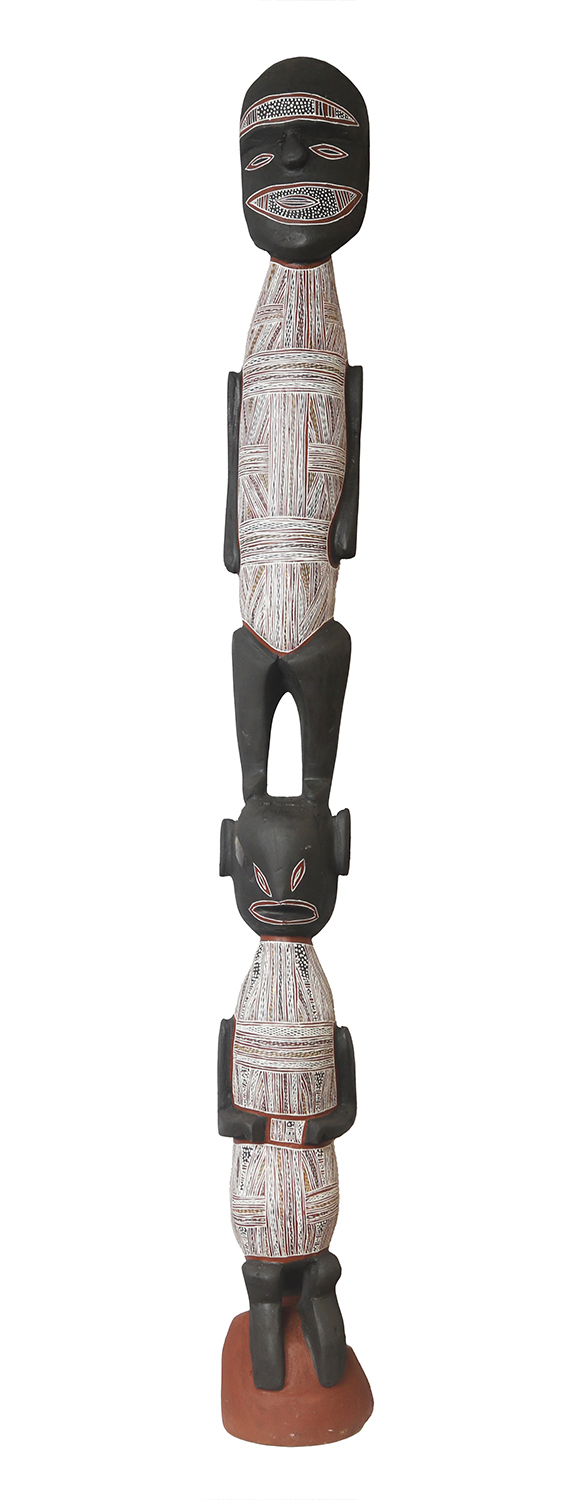
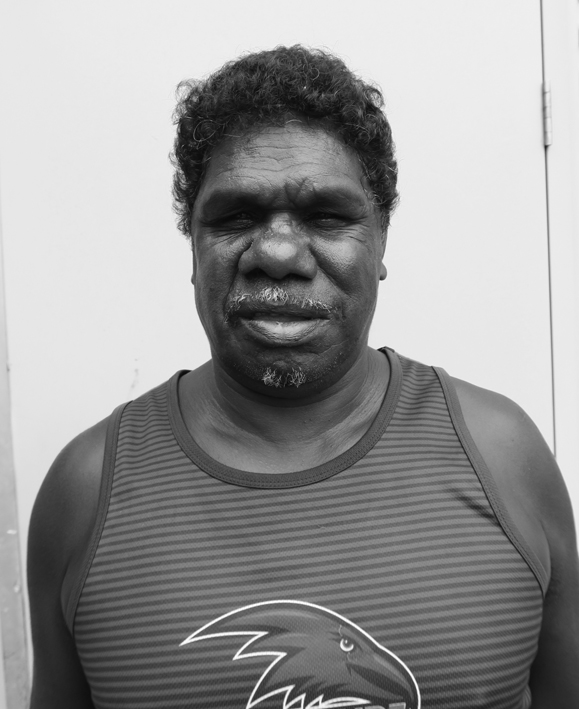
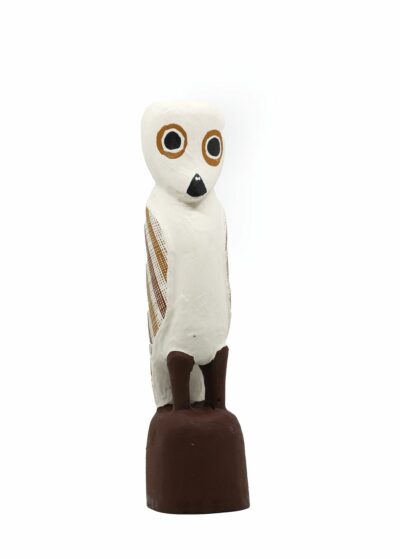
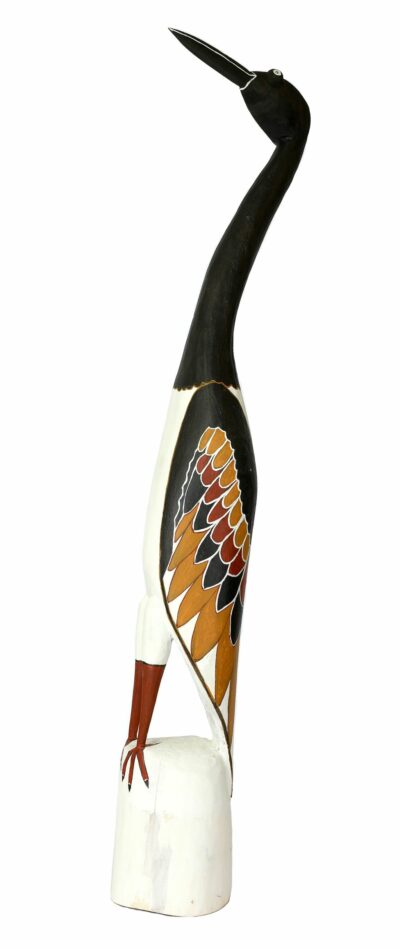
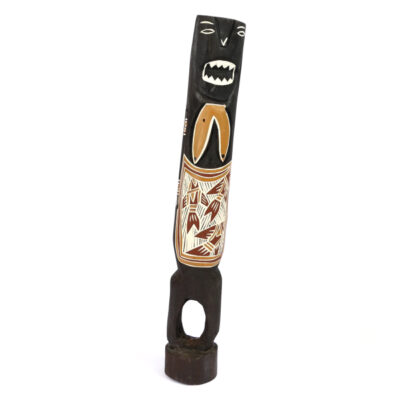
Reviews
There are no reviews yet.